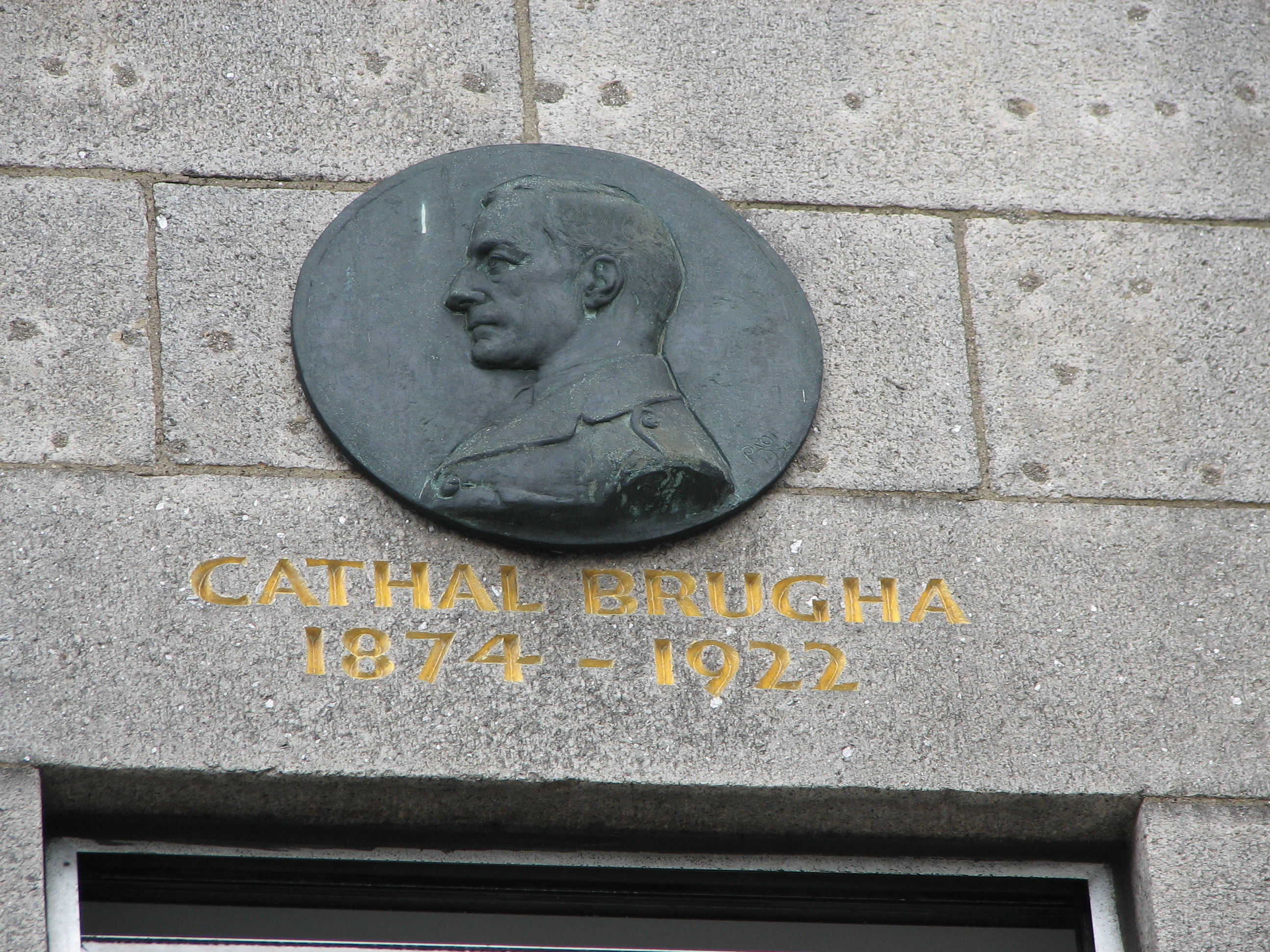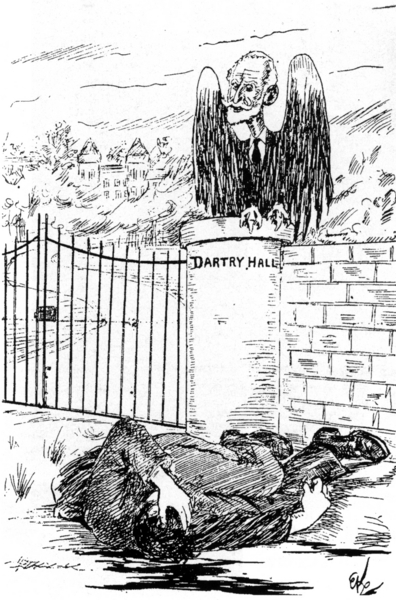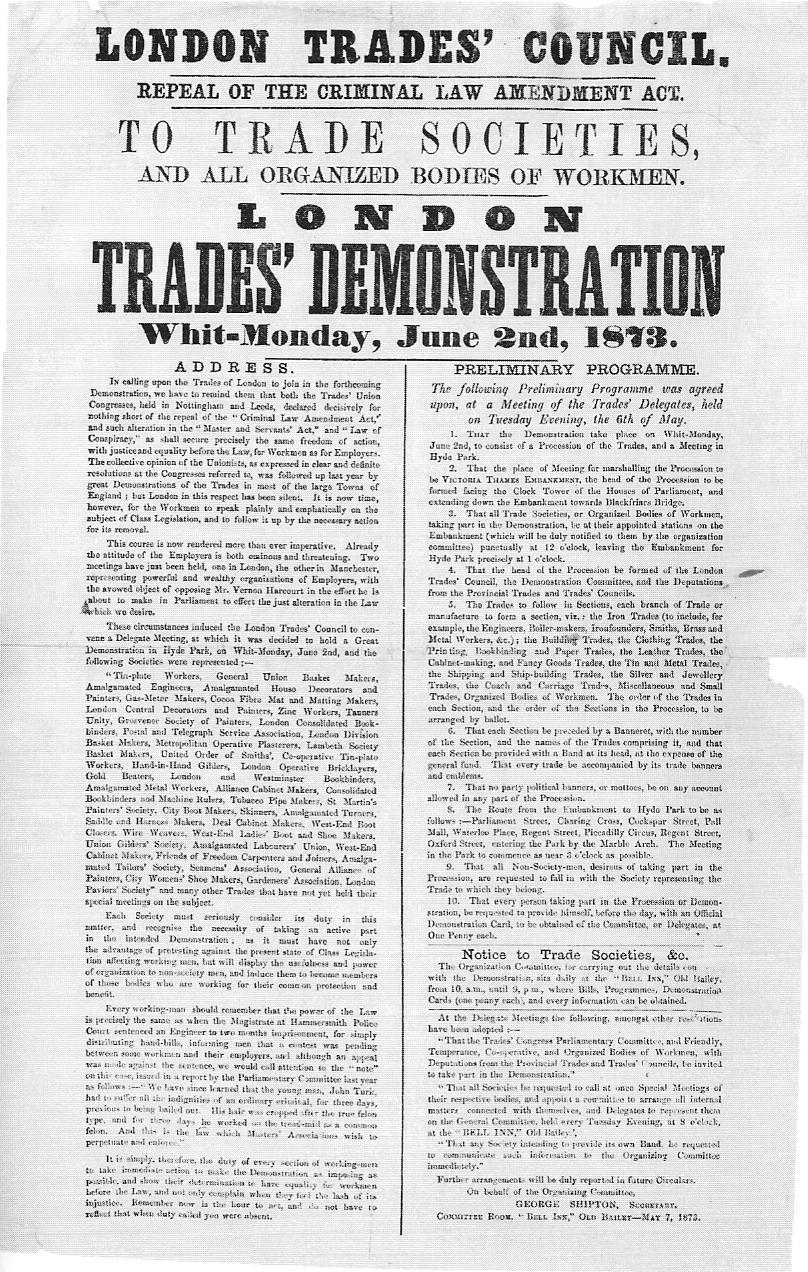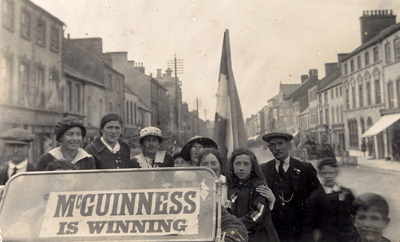|
أ‰amonn Ceannt
أ‰amonn Ceannt (21 September 1881 – 8 May 1916), born Edward Thomas Kent, was an Irish republican, mostly known for his role in the Easter Rising of 1916. Background Ceannt was born in the little village of Ballymoe, overlooking the River Suck in County Galway. His parents were James Kent (4 July 1839 – 1895) and Joanne Galway. (They were married on 5 July 1870.) He was the sixth of seven children, the others being William, Michael, Richard, Nell, John and James. His father, James Kent, was a Royal Irish Constabulary officer. Stationed in Ballymoe, in 1883 he was promoted and transferred to Drogheda, County Louth where he lived until أ‰amonn was eight years old. When his father retired from the force, when Eamonn was twelve, the family moved from Ardee to Dublin. They were a very religious Catholic family and it has been said that Ceannt's religious teaching as a child stayed with him for the rest of his life. Two events that evoked nationalism at the end of the 19th centu ... [...More Info...] [...Related Items...] OR: [Wikipedia] [Google] [Baidu] |
Ballymoe
Ballymoe (historically ''Bellamoe'', from ) is a village in County Galway, Ireland. Ballymoe is situated on the western side of the River Suck that separates counties County Galway, Galway and County Roscommon, Roscommon. The N60 road (Ireland), N60 national secondary road meets the R360 road (Ireland), R360 Regional road (Ireland), regional road in the centre of the village. History The name Bأ©al أپtha Mأ³ is derived from a fort which was built by Medb, Meabh of Connacht, under the order of Mogh. The fort and village would later become known as أپtha Mogh Mأ³r and Bأ©al أپtha Mogh. The town is now the centre of a small rural area involved in scale mixed farming. Raised bogs, forts and a mass rock from penal times are features of Ballymoe today. People *أ‰amonn Ceannt, one of the leaders of the Easter Rising and signatory to the Proclamation of the Irish Republic was born in the police barracks in Ballymoe where his father James Kent, an officer in the Royal Irish Constabul ... [...More Info...] [...Related Items...] OR: [Wikipedia] [Google] [Baidu] |
Conradh Na Gaeilge
(; historically known in English as the Gaelic League) is a social and cultural organisation which promotes the Irish language in Ireland and worldwide. The organisation was founded in 1893 with Douglas Hyde as its first president, when it emerged as the successor of several 19th century groups such as the Gaelic Union. The organisation was a spearhead of the Gaelic revival and of '' Gaeilgeoir'' activism. While Hyde succeeded in drawing unionists to the League, the organisation increasingly gave expression to the nationalist impulse behind the language revival. From 1915, members of its executive acknowledged the leadership of the Irish Republican Brotherhood in the struggle for Irish statehood. After the creation of the Irish Free State, and limited advances with respect to the teaching and official use of the language, many members transferred their commitment to the new institutions, political parties and education system. In 2008, Conradh na Gaeilge adopted a new constit ... [...More Info...] [...Related Items...] OR: [Wikipedia] [Google] [Baidu] |
Marrowbone Lane
Marrowbone Lane () is a street off Cork Street on the south side of Dublin, Ireland. History Naming convention The street is likely named after Marylebone in London; Pimlico is located right next to it, and other London-inspired street names are nearby, like Spitalfields. These were brought to Dublin by London wool-workers, who settled in the area after William III's conquest of Ireland in 1690. Marylebone, London, commonly pronounced like "Marrow-bone", is named after the church of St Mary at the Bourne, later corrupted to "Mary le Bone", Middle French for "Mary the Good." The Irish street name reproduces this error, literally meaning "Lane of Mary the Good." By 1743, the street name was corrupted to Marrowbone Lane. Easter Rising Fighting took place on the street during the Easter Rising of 1916. The distillery was used as a strongpoint by a force of more than a hundred rebels under the command of أ‰amonn Ceannt, which also held the nearby South Dublin Union. Ceannt was ... [...More Info...] [...Related Items...] OR: [Wikipedia] [Google] [Baidu] |
Cathal Brugha
Cathal Brugha (; born Charles William St John Burgess; 18 July 1874 – 7 July 1922) was an Irish republican politician who served as Minister for Defence from 1919 to 1922, Ceann Comhairle of Dأ،il أ‰ireann in January 1919, the first president of Dأ،il أ‰ireann from January 1919 to April 1919 and Chief of Staff of the Irish Republican Army from 1917 to 1918. He served as a Teachta Dأ،la (TD) from 1918 to 1922. He was active in the Easter Rising, the Irish War of Independence and the Irish Civil War, and was the first Ceann Comhairle (chairperson) of Dأ،il أ‰ireann as well as the president of Dأ،il أ‰ireann, the then title of the head of government. Early life Brugha was born in Dublin, of mixed Roman Catholic and Protestant parentage. He was the tenth child in a family of fourteen. His father, Thomas, was a cabinet maker and antique dealer who had been disinherited by his family for marrying an Irish Catholic, Maryanne Flynn. Brugha attended Colmcille Schools on Dominick ... [...More Info...] [...Related Items...] OR: [Wikipedia] [Google] [Baidu] |
Proclamation Of The Irish Republic
The Proclamation of the Republic (), also known as the 1916 Proclamation or the Easter Proclamation, was a document issued by the Irish Volunteers and the Irish Citizen Army during the Easter Rising in Ireland, which began on 24 April 1916. In it, the Military Council of the Irish Republican Brotherhood, writing in English as the "Provisional Government of the Irish Republic," proclaimed Ireland's independence from the United Kingdom of Great Britain and Ireland, United Kingdom. The reading of the proclamation by Patrick Pearse outside the General Post Office, Dublin, General Post Office (GPO) on Sackville Street (now called O'Connell Street), Dublin's main thoroughfare, marked the beginning of the Rising. The proclamation was modelled on a similar independence proclamation issued during the 1803 rebellion by Robert Emmet. Principles of the proclamation Although the Rising failed in military terms, the principles of the Proclamation to varying degrees influenced the thinkin ... [...More Info...] [...Related Items...] OR: [Wikipedia] [Google] [Baidu] |
Dublin Lock-out
The Dublin lock-out was a major industrial dispute between approximately 20,000 workers and 300 employers that took place in Dublin, Ireland. The dispute, lasting from 26 August 1913 to 18 January 1914, is often viewed as the most severe and significant industrial dispute in Irish history. Central to the dispute was the workers' labour rights, right to unionise. Background Poverty and housing Many of Dublin's workers lived in terrible conditions in tenements. For example, over 830 people lived in just 15 houses in Henrietta Street, Dublin, Henrietta Street's Georgian tenements. At 10 Henrietta Street, the Religious Sisters of Charity, Irish Sisters of Charity ran a Magdalene laundries in Ireland, Magdalene laundry that was inhabited by more than 50 single women. An estimated four million pledges were taken in pawnbrokers every year. The infant mortality rate among the poor was 142 per 1,000 births, extraordinarily high for a European city. The situation was made considerably w ... [...More Info...] [...Related Items...] OR: [Wikipedia] [Google] [Baidu] |
Trade Unionism
A trade union (British English) or labor union (American English), often simply referred to as a union, is an organization of workers whose purpose is to maintain or improve the conditions of their employment, such as attaining better wages and Employee benefits, benefits, improving Work (human activity), working conditions, improving safety standards, establishing complaint procedures, developing rules governing status of employees (rules governing promotions, just-cause conditions for termination) and protecting and increasing the bargaining power of workers. Trade unions typically fund their head office and legal team functions through regularly imposed fees called ''union dues''. The union representatives in the workforce are usually made up of workplace volunteers who are often appointed by members through internal democratic elections. The trade union, through an elected leadership and bargaining committee, bargains with the employer on behalf of its members, known as t ... [...More Info...] [...Related Items...] OR: [Wikipedia] [Google] [Baidu] |
Con Colbert
Cornelius Bernard Colbert (; 19 October 1888 – 8 May 1916)D.J. Hickey & J. E. Doherty, ''A New Dictionary of Irish History from 1800'', Gill & MacMillan (Dublin), , Pg.75 was an Irish rebel and pioneer of Fianna أ‰ireann. For his part in the Easter Rising of 1916, he was shot by firing squad in Kilmainham Gaol, Dublin, on 8 May 1916. Early life Born in the townland of Moanleana, Castlemahon, County Limerick, he was the fourth youngest of thirteen children of Michael Colbert, a farmer, and Honora McDermott. His family moved to the village of Athea when Con was three years old. He was educated at the local national school. In 1901, his family were living in the townland of Templeathea West. A younger brother, James, and a cousin, Michael Colbert, would later serve as TDs. He left Athea at the age of 16 and went to live with his sister Catherine in Ranelagh, County Dublin. Colbert continued his education at a Christian Brothers school in North Richmond street. He was emplo ... [...More Info...] [...Related Items...] OR: [Wikipedia] [Google] [Baidu] |
Seأ،n Heuston
Seأ،n Heuston ( ; ;Piaras F. Mac Lochlainn, ''Last words : letters and statements of the leaders executed after the rising at Easter 1916'', Dublin: Stationery Office, born John Joseph Heuston; 21 February 1891 – 8 May 1916) was an Irish republican rebel and member of Fianna أ‰ireann who took part in the Easter Rising of 1916. With about 20 Volunteers, he held the Mendicity Institution on the River Liffey for over two days, though it was originally only intended to be held for 3–4 hours. He was executed by firing squad on 8 May in Kilmainham Gaol. His court-martial record at Kew spells his name as Hewston J.J.. Early life Heuston was born at Gloucester Street in Dublin on 21 February 1891, the son of clerk John Heuston and Maria McDonald. Educated by the Christian Brothers, he later worked as a railway clerk in Limerick and while there took an active part in Fianna أ‰ireann, of which he was an officer. Seأ،n Heuston arranged for members who could not afford to buy their u ... [...More Info...] [...Related Items...] OR: [Wikipedia] [Google] [Baidu] |
Seأ،n Mac Diarmada
Seأ،n Mac Diarmada (27 January 1883 – 12 May 1916), also known as Seأ،n MacDermott, was an Irish republican political activist and revolutionary leader. He was one of the seven leaders of the Easter Rising of 1916, which he helped to organise as a member of the Military Committee of the Irish Republican Brotherhood (IRB) and was the second signatory of the Proclamation of the Irish Republic. He was executed for his part in the Rising at age 33. Brought up in County Leitrim (Kiltyclogher, Glenfarne), he was a member of many associations which promoted the cause of the Irish language, Gaelic revival and Irish nationalism in general, including the Gaelic League and (early in his career) the Irish Catholic fraternity the Ancient Order of Hibernians. He was the national organiser for Sinn Fأ©in, and later manager of the newspaper '' Irish Freedom'', started in 1910 by Bulmer Hobson and others. Early life Mac Diarmada was born John MacDermott, in County Leitrim, an area where t ... [...More Info...] [...Related Items...] OR: [Wikipedia] [Google] [Baidu] |
Sinn Fأ©in
Sinn Fأ©in ( ; ; ) is an Irish republican and democratic socialist political party active in both the Republic of Ireland and Northern Ireland. The History of Sinn Fأ©in, original Sinn Fأ©in organisation was founded in 1905 by Arthur Griffith. Its members founded the revolutionary Irish Republic and its parliament, the First Dأ،il, and many of them were active in the Irish War of Independence, during which the party was associated with the Irish Republican Army (1919–1922). The party split before the Irish Civil War and again in its aftermath, giving rise to the two traditionally dominant parties of Irish politics: Fianna Fأ،il, and Cumann na nGaedheal (which merged with smaller groups to form Fine Gael). For several decades the remaining Sinn Fأ©in organisation was small and often without parliamentary representation. It continued its association with the Irish Republican Army (1922–1969), Irish Republican Army. Another split in 1970 at the start of the Troubles led to th ... [...More Info...] [...Related Items...] OR: [Wikipedia] [Google] [Baidu] |
Lily O'Brennan
Elizabeth â€کLily’ O'Brennan (20 August 1878 – 31 May 1948), was an Irish republican, writer and playwright. Background O'Brennan was born in Summer Street, Dublin, the third daughter of Francis Brennan, auctioneer, and Elizabeth Anne Butler. They were a nationalist family and later added the 'O' prefix to their name. Her sister أپine O'Brennan married أ‰amonn Ceannt, and her other sister Kathleen O'Brennan became a playwright and journalist. Her father died in 1880, her mother in 1930. O'Brennan became a teacher and contributed to both Irish and American periodicals. She wrote a play, ''May Eve in Stephen's Green'', produced with Mأ،ire Nic Shiubhlaigh and performed in Father Mathew Hall, Church Street, Dublin in 1912; it was inspired by a statue of James Clarence Mangan in St Stephen's Green. The play got good reviews. Nationalism O'Brennan attended the inaugural meeting of Cumann na mBan, held in Wynn's Hotel, Dublin, and was a member of its central branch. When C ... [...More Info...] [...Related Items...] OR: [Wikipedia] [Google] [Baidu] |







